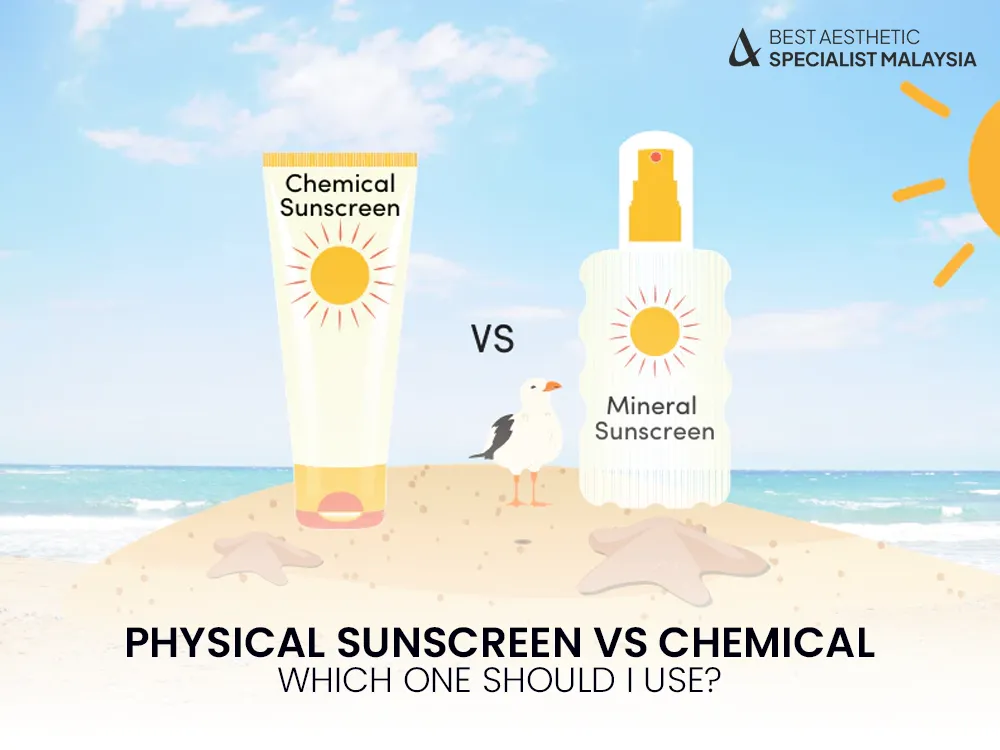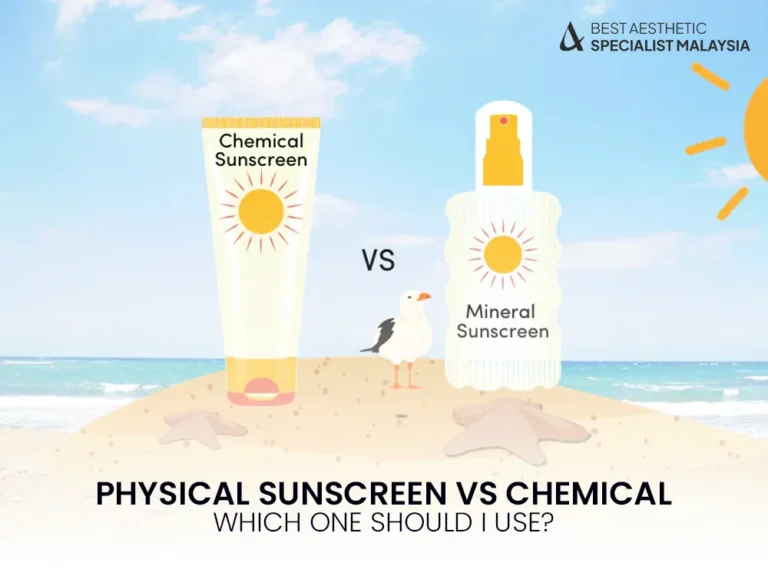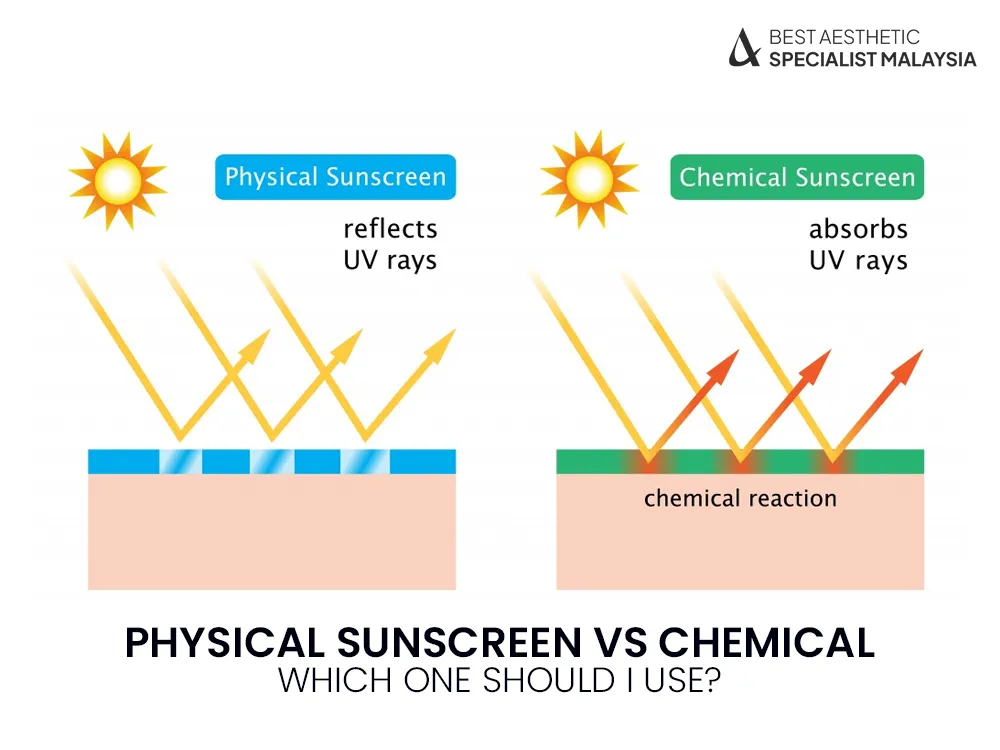What Is Physical Sunscreen?

Physical sunscreen, also called mineral sunscreen, is a type of sun protection that uses zinc oxide and titanium dioxide as its active ingredients. Unlike chemical formulas that absorb UV rays, this option forms a barrier on the skin’s surface to block and reflect both UVA and UVB rays. Because of its gentle, non-irritating formula, dermatologists often recommend physical sunscreen for sensitive, acne-prone, or post-treatment skin. It provides broad spectrum coverage, works immediately after application, and is safe for children and pregnant women.
How Physical Sunscreen Works
Physical sunscreen functions differently from chemical types, which absorb UV rays and transform them into heat. Instead, mineral formulations act as a shield that reflects harmful radiation before it penetrates the skin.
Zinc Oxide
Zinc oxide provides superior UVA protection, the rays responsible for skin aging, and also covers UVB rays that cause sunburn.
Titanium Dioxide
Titanium dioxide offers reliable defense against UVB, though its UVA coverage is slightly less comprehensive than zinc oxide.
Thanks to these minerals, physical sunscreen is photostable, meaning it does not break down quickly in the sun.
Benefits
Immediate Protection
Physical sunscreen starts working the moment it is applied, unlike chemical alternatives that need 20–30 minutes to activate.
Gentle on Sensitive Skin
Because it does not contain harsh chemical filters, this option is ideal for people with rosacea, eczema, melasma, or acne.
Broad Spectrum Coverage
It shields against both UVA and UVB rays, reducing the risk of sunburn, pigmentation, wrinkles, and skin cancer.
Non-Comedogenic
Physical sunscreen is less likely to clog pores, making it suitable for acne-prone or oily skin.
Environmentally Friendly
Mineral-based products are reef-safe, avoiding oxybenzone and octinoxate, which damage coral reefs.
Physical Sunscreen vs Chemical Sunscreen
What Is Chemical Sunscreen?
Chemical sunscreen is a type of sun protection that uses organic compounds such as avobenzone, oxybenzone, octinoxate, and octocrylene to absorb UV radiation. Instead of sitting on the skin’s surface like mineral formulas, these filters penetrate slightly into the skin, where they transform UV rays into heat and release it from the body.
| Aspect | Physical Sunscreen | Chemical Sunscreen |
|---|---|---|
| Active Ingredients | Zinc oxide, Titanium dioxide | Avobenzone, Oxybenzone, Octinoxate |
| How It Works | Reflects and scatters UV rays | Absorbs UV rays, converts to heat |
| Application | Instant protection | Needs 20–30 minutes |
| Skin Type | Best for sensitive, acne-prone | May cause irritation or clogged pores |
| Finish | Thicker, may leave a white cast | Lightweight, usually invisible |
| Environmental Impact | Generally reef-safe | Some filters harm coral reefs |
Data Fact: According to Grand View Research, chemical sunscreens account for over 55% of global sunscreen sales, mainly due to their transparent finish and ease of use, while mineral sunscreens are gaining popularity among consumers seeking safer, dermatologist-recommended options.
What to Look for in a Physical Sunscreen
SPF Rating
Choose SPF 30–50 for daily use. Higher SPF may be needed for outdoor sports or beach activities.
Broad Spectrum Protection
Ensure it protects against both UVA and UVB rays.
Water Resistance
For swimming or heavy sweating, a water-resistant formula is essential.
Texture and Finish
Select a matte option for oily skin or a hydrating formula for dry skin.
Non-Nano Zinc Oxide
Larger particle formulations remain on the skin surface, ensuring safe yet effective UV protection.
Estimated Prices in Malaysia
In Malaysia, physical sunscreen ranges from RM 30 to RM 200 depending on brand and formulation.
Neutrogena Sheer Zinc SPF 50+: RM 50–60
La Roche-Posay Anthelios Mineral SPF 50: RM 120–150
Anessa Perfect UV Skincare Milk SPF 50+ PA++++: RM 150–200
Aveeno Positively Mineral SPF 50: RM 60–80
Budget-friendly options provide basic protection, while higher-end brands often include skincare benefits such as antioxidants and hydration.
Who Should Use Physical Sunscreen?
Physical sunscreen is especially suitable for sensitive skin. Dermatologists recommend it for people with rosacea, melasma, or eczema, since chemical filters may worsen irritation. Patients on acne treatments like isotretinoin also benefit from its non-irritating protection. Outdoor workers, athletes, and those exposed to intense sun should choose this option for consistent broad spectrum defense.
How to Choose the Best Physical Sunscreen
The best products list zinc oxide or titanium dioxide clearly. Select SPF 30 or higher with broad spectrum labeling. For acne-prone skin, look for formulas that are non-comedogenic, fragrance-free, and water resistant.
In Malaysia, dermatologist-recommended brands are more reliable, as they meet Ministry of Health guidelines and are formulated for tropical climates. Choosing the right physical sunscreen ensures effective UV protection without irritation.
Common Myths About Physical Sunscreens
“They always leave a white cast” → Modern tinted and micronized formulas minimize this issue.
“Only for fair skin” → Today’s mineral sunscreens are suitable for all skin tones.
“Not as effective as chemical” → Research confirms physical sunscreen provides strong, broad spectrum coverage, especially for sensitive and post-treatment skin.
Conclusion
Consistent use of physical sunscreen is essential for preventing skin cancer, premature aging, and pigmentation disorders caused by UV exposure. UVA rays penetrate clouds and glass, so daily use is critical.
Incorporating physical sunscreen into your routine is one of the most effective ways to maintain healthy, youthful skin. With innovations like lightweight and tinted formulations, modern mineral sunscreens are user-friendly, dermatologist-approved, and an essential part of long-term skin health.


